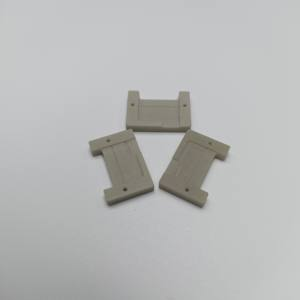Discover Premium Ceramic Products | Durability & Elegance United | Advanced Ceramics
1. Introduction
Yesterday, Ceramic Tech Today reported a 17% quarterly surge in high-purity silicon nitride powder market demand, driven by aerospace and semiconductor applications. This growth spotlights the essential role of specialized manufacturing equipment like silicon carbide crucibles in advanced material production. These crucibles serve as unsung heroes in high-tech industries where extreme conditions demand exceptional material performance.

2. Silicon Carbide Crucibles: Material Superiority
Silicon carbide crucibles outperform alternatives in extreme environments. Their unique properties enable processes impossible with conventional materials. Unlike traditional ceramics, they maintain structural integrity under thermal and chemical stress.
2.1. Critical Performance Characteristics
Exceptional thermal conductivity (120 W/mK) allows rapid heat transfer. Ultra-high melting point (2,730°C) withstands extreme processing temperatures. Superior thermal shock resistance prevents cracking during rapid temperature changes. Chemical inertness resists reaction with molten metals and corrosive substances.
2.2. Comparative Material Analysis
When evaluating boron carbide vs silicon carbide, key differences emerge. Boron carbide offers greater hardness but inferior thermal conductivity. Silicon carbide provides better oxidation resistance above 1,000°C. This makes silicon carbide crucibles preferable for most high-temperature applications.
3. Niche Application: High-Purity Silicon Nitride Production

Silicon carbide crucibles enable cutting-edge silicon nitride ceramic manufacturing. Their stability at 1,800-2,000°C facilitates crucial powder synthesis processes. This application represents a specialized intersection of advanced material technologies.
3.1. Manufacturing Process Breakdown
The production begins within silicon carbide crucibles in specialized silicon nitride crucible factories. Precise atmospheric control prevents contamination during reaction sintering. Crucibles maintain purity levels below 10ppm metallic impurities. Resulting powders form the basis for high-performance components.
3.2. Downstream Product Applications
High-purity silicon nitride powder enables diverse components. These include silicon nitride rings for industrial bearings. Custom silicon nitride heat shields for aerospace. Silicon nitride plates for semiconductor handling. Each application leverages the material’s exceptional thermal and mechanical properties.
4. Industrial Component Manufacturing
Beyond powder production, silicon carbide crucibles facilitate creation of specialized industrial ceramics. Their thermal management capabilities support complex manufacturing processes.

4.1. High-Temperature System Components
Manufacturers produce silicon carbide burner nozzles for industrial furnaces. Silicon carbide brick linings for extreme environments. RBSIC silicon carbide tile blocks for kiln construction. Silicon carbide ceramic columns support high-mass structures.
4.2. Specialized Industrial Parts
Production includes silicon carbide ceramic grinding discs for precision machining. Silicon carbide thermocouple protection tubes for accurate measurements. Silicon carbide mullite tubes for thermal processing systems. Silicon carbide porous ceramic tubes for filtration applications.
5. Advanced Consumer Ceramics
The same manufacturing principles enable premium consumer products. Silicon carbide technology now appears in sophisticated domestic applications.
5.1. High-Performance Culinary Products
Specialized kilns using silicon carbide crucibles produce silicon carbide ceramic baking dishes. These include silicon carbide ceramic casserole dishes with lids. Silicon carbide ceramic serving platters for professional kitchens. Silicon carbide ceramic pie dishes with exceptional thermal distribution.
5.2. Premium Tableware Innovations
Manufacturers create silicon carbide ceramic dinner plates for high-end restaurants. Silicon carbide black ceramic plates with distinctive finishes. Silicon carbide ceramic pasta bowls with thermal retention properties. Silicon carbide ceramic childrens plates with enhanced durability.
6. Future Developments and Challenges
Material scientists continue enhancing silicon carbide formulations. Research focuses on increasing service life under cyclic thermal loading. Development of custom geometries addresses specialized industrial needs.
6.1. Emerging Applications
Silicon carbide ceramic tubes for next-generation hydrogen production. Silicon carbide piezoelectric ceramic discs for sensors. Silicon carbide ceramic plumbing pipes for corrosive environments. These innovations expand industrial possibilities.
6.2. Technical Limitations
Cost remains prohibitive for some applications. Complex shapes challenge manufacturing capabilities. Material brittleness requires careful handling during installation. Ongoing research seeks solutions to these constraints.
7. Conclusion
Silicon carbide crucibles remain indispensable in advanced ceramic manufacturing. Their unique properties enable production of high-purity materials and specialized components across industries. As technology advances, these crucibles will continue facilitating innovations in both industrial and consumer ceramics. The growing silicon nitride powder market underscores their critical role in modern materials science.
